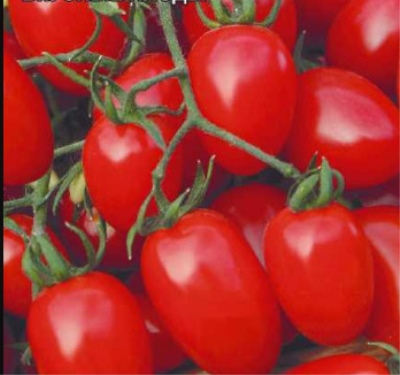
- Authors: G. A. Kudryavtseva, Yu. V. Fotev, L. P. Altunina, M. A. Kotelnikova, S. N. Kondakov
- Year of approval: 2008
- Category: grade
- Growth type: determinant
- Appointment: fresh consumption, for whole fruit preservation
- Ripening period: mid-early
- Ripening time, days: 107-110
- Growing conditions: for open ground, for film greenhouses
- Marketability: Yes
- Transportability: Yes
There are more than 10 varieties of Cream among tomato crops. And in almost every summer cottage there are tomatoes of this shape. It's kind of a classic. The red cream stands out among them primarily for its tiny size - the small red cream grows in beautiful even bunches and belongs to the cherry format. Culture can decorate any area with such bright fruits and at the same time be beneficial, because the fruits are universal, they can be used as you like, they will be tasty both fresh and in blanks.
Breeding history
The variety was developed by breeders from the "Seeds of Altai" agricultural firm - G. A. Kudryavtseva, Yu. V. Fotev, L. P. Altunina, M. A. Kotelnikova, S. N. Kondakov. It is worth saying that this is exactly the variety, and you can guaranteed to collect your own seeds for future planting at the end of the season. In 2008 it was included in the lists of the State Register. Recommended for cultivation throughout the territory of the Russian Federation both in the open field and under a film in personal subsidiary plots.
Description of the variety
Despite the fact that Red Cream is a determinant plant, it is distinguished by its tall growth, reaching a height of 90-110 cm. The foliage is small, greens of a dark shade. A simple inflorescence. Brushes include 5-7 smooth, even and dense fruits. The peduncle has an articulation.
The main qualities of the fruit
The fruits are plum-shaped, cylindrical. The tone of unripe tomatoes is green, but with a speck next to the stalk. In accordance with the name, a ripe tomato has a red, lacquered, glossy color. The number of seed nests is minimal - there are only two of them. Cherry tomato weighs 7-9 grams. The variety has excellent indicators of transportability, keeping quality (from one to one and a half months), as well as resistance to fruit cracking.
Taste characteristics
Red cream is ranked among salad, pickling crops, and is also used for whole-fruit preparations. Cherry berries are very sweet, and the great qualities of the fruit are manifested in any form - both fresh and canned.
Ripening and fruiting
Ripening of red fruits occurs 107-110 days after seed germination. The culture is classified as both mid- and early-maturing.
Yield
The yield of marketable fruits laid down in the variety reaches 3.0-3.2 kg / m2.
The timing of planting seedlings and planting in the ground
The first month of spring is marked by the planting of seed in containers filled with soil. From above, the seeds are sprinkled with a centimeter layer of peat, poured with cold water through a strainer, and covered with a film. Then the plantings are placed where the temperature is kept within + 25 ° C. The emergence of shoots will be a signal to remove the film. Now the seedlings are placed in a bright place. For about a week, the temperature is maintained at 15-16 ° C, then it is raised again, but already up to 20-22 ° C.
When the first 1-2 leaves appear, the seedlings dive. Then, upon reaching the age of 60-65 days, as well as the appearance of 6-7 leaves and at least 1 flower brush, the seedlings move to the greenhouse or to an open bed.

Growing tomato seedlings is an extremely important process, because it largely depends on whether the gardener can harvest at all. All aspects must be taken into account, from seedbed preparation to planting in the ground.
Landing scheme
It is necessary to follow the 40x40 cm landing pattern.

Growing and caring
In the process of development and growth, tomato seedlings Red Cream need to be tied to a strong support and formation. A determinant culture outdoors is grown, leaving 1-2 trunks; in a closed field, a larger number of stems are used, namely 3-4. The variety responds well to sparse but abundant irrigation.
For greenhouse cultivation, experts recommend magnesium supplements. When the fruits are poured, it is better to use potash fertilizers.
Unripe tomatoes can be safely removed from the bush, they ripen perfectly indoors.




A plant needs different micronutrients at each stage of growth. All fertilizers can be divided into two groups: mineral and organic. Folk remedies are often used: iodine, yeast, bird droppings, eggshells.
It is important to observe the rate and period of feeding. This also applies to folk remedies and organic fertilizers.
Disease and pest resistance
The Red Cream variety has excellent immunity. Possesses good resistance to many ailments of tomatoes, especially well resists the tobacco mosaic virus (TMV).



























































































